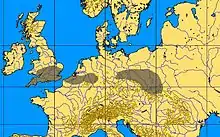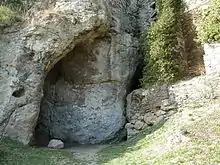Lincombian-Ranisian-Jerzmanowician
Lincombian-Ranisian-Jerzmanowician (LRJ) was a culture or technocomplex (industry) dating to the beginning Upper Paleolithic, about 43,000 years ago. It is characterised by leaf points made on long blades, which are thought to have been made by the last Neanderthals, although some researchers have suggested that it could be a culture of the first anatomically modern humans in Europe. It is rarely found, but extends across northwest Europe from Wales to Poland.[1][2]
 | |
| Geographical range | Northwest Europe |
|---|---|
| Period | Upper Paleolithic |
| Dates | c. 43,000 years BP |
| The Paleolithic |
|---|
| ↑ Pliocene (before Homo) |
| ↓ Mesolithic |
Major sites

The cave of Ilsenhöhle in Thuringia
The technocomplex is named after findings in Kents Cavern, Lincombe Hill, Torquay (Devon, England), the cave of Ilsenhöhle in Ranis (Thuringia, Germany), and the Jerzmanowicien cave in Ojców (Kraków County, Poland). About 40 different sites have been identified.[3]
See also
- Transitional cultures : Châtelperronian - Uluzzian - Bohunician - Szeletian
- Follow-on cultures : Gravettian - Sungir - Kostenki
- Haplogroup I-M170
References
- Ashton, Nick (2017). Early Humans. London: William Collins. p. 315. ISBN 978-0-00-815035-8.
- Flas, Damien (5 December 2011). "The Middle to Upper Paleolithic transition in Northern Europe: the Lincombian-Ranisian-Jerzmanowician and the issue of acculturation of the last Neanderthals". World Archaeology. 43 (4): 605–627. doi:10.1080/00438243.2011.624725.
- Flas Damien. 2006. La transition du Paléolithique moyen au supérieur dans la plaine septentrionale de l'Europe. Les problématiques du Lincombien-Ranisien-Jerzmanowicien. PhD diss., Université de Liège, Belgium, 2006.
This article is issued from Wikipedia. The text is licensed under Creative Commons - Attribution - Sharealike. Additional terms may apply for the media files.